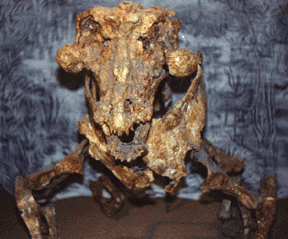
Estemmenosuchus
uralensis -Tchudinov, 1960- skeleton
Therapsida:Eotheriodontia:
Estemmenosuchidae
Locality: Ocher, Perm Region, eastern
European Russia
Age: Late Permian, 255 million years ago
Meaning of name: "Crowned
crocodile"
The
rigid stems of sphenophyt plants, giant relatives of the living horstails,
accumulated
in the coastal parts of the well-heated brackish basins.
Partially-rotted sphenophyt
remains with mushrooms, which sprouted on them,
became a soft nutritious heap.
This heap could be eaten up by the huge
herbivorous eotheriodonts of the genus
Estemmenosuchus.
They grasped soft forage with their long and strong front teeth
and swallowed without
chewing, as their weak and thin lateral teeth only served
to keep food in the mouth.
Represented is the skeleton of a large herbivore in
the group Dinocephalia.
The skeleton was preserved in a channel flood deposit.
With
large horns projecting both upwards and outwards and a sprawling
posture as well
as reduced teeth behind the large canines, these massive,
clumsy-looking animals
would seem almost certain to have been herbivores.
However, at least one expert
on mammal-like reptiles asserts that Estemmenosuchus
was a carnivore, exerting
great force at the tips of the chisel-like front teeth
when slicing the flesh
and bones of its prey.
Estemmenosuchus may have been warm-blooded with an internal
heat engine like
mammals. Another mechanism is what is called inertial
warm-bloodedness-maintenance
of a high body temperature by controlling loss of heat.
This could be achieved
by the build of this animal in that it was a large,
compact form with a low surface
area to volume ratio-and so, little heat escaped.
At the moment scientists cannot
resolve which theory is correct.





